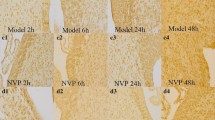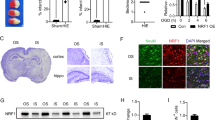Abstract
The experiments were designed to study the glutamate gene expression during epilepsy in adult and hypoxic insult to brain during the neonatal period and the therapeutic role of neuroprotective supplements. We investigated the role of metabotropic glutamate-8 receptor (mGluR8) gene expression in cerebellum during epilepsy and neuroprotective role of Bacopa monnieri extract in epilepsy. We also studied the effect of NMDA receptor 1 (NMDAR1) gene expression during neonatal hypoxia and therapeutic role of glucose, oxygen and epinephrine supplementation. During epilepsy a significant down-regulation (P < 0.01) of mGluR8 gene expression was observed which was up-regulated (P < 0.05) near control level after B. monnieri treatment which is supported by Morris water maze experiment. In hypoxic neonates we observed up-regulation (P < 0.001) of the NMDAR1 gene expression whereas glucose and glucose + oxygen was able to significantly reverse (P < 0.001) the gene expression to near control level when compared to hypoxia and epinephrine treatment which was supported by open field test. Our results showed that B. monnieri treatment to epileptic rats significantly brought the reversal of the down-regulated mgluR8 gene expression toward control level. In neonatal rats, hypoxia induced expressional and functional changes in the NMDAR1 receptors of neuronal cells which is corrected by supplementation of glucose alone or glucose followed by oxygen during the resuscitation to prevent the glutamate related neuronal damage. Thus, the results suggest the clinical significance of corrective measures for epileptic and hypoxic management.




Similar content being viewed by others
References
Jorge RE, Robinson RG, Arndt SV (1993) Are there symptoms that are specific for depressed mood in patients with traumatic brain injury? J Nerv Ment Dis 181:91–99
Van Reekum R, Cohen T, Wong J (2000) Can traumatic brain injury cause psychiatric disorders? J Neuropsychiatry Clin Neurosci 12:316–327
McIntosh TK (1994) Neurochemical sequelae of traumatic brain injury. Cereb Brain Metab Rev 6:109–162
Olney JW (1982) The toxic effects of glutamate and related compounds in the retina and the brain. Retina 2:341–359
Caccamo D, Campisi A, Currò M et al (2004) Excitotoxic and post-ischemic neurodegeneration: involvement of transglutaminases. Amino Acids 27:373–379
Choi DW (1994) Calcium and excitotoxic neuronal injury. Ann NY Acad Sci 747:162–171
Zhang Y, Lipton P (1999) Cytosolic Ca2+changes during in vitro ischemia in rat hippocampal slices: major roles for glutamate and Na+-dependent Ca2+ release from mitochondria. J Neurosci 19:3307–3315
Launes J, Siren J, Viinikka L et al (1998) Does glutamate mediate brain damage in acute encephalitis? Neuroreport 9:577–581
Prince HK, Conn PJ, Blackstone CD et al (1995) Down-regulation of AMPA receptor subunit GluR2 in amygdaloid kindling. J Neurochem 64:462–465
Covolan L, Smith RL, Mello LE (2000) Ultrastructural identification of dentate granule cell death from pilocarpine-induced seizures. Epilepsy Res 41:9–21
Mello LE, Cavalheiro EA, Tan AM (1993) Circuit mechanisms of seizures in the pilocarpine model of chronic epilepsy: cell loss and mossy fiber sprouting. Epilepsia 34:985–995
Kral T, Erdmann E, Sochivko D et al (2003) Downregulation of mGluR8 in pilocarpine epileptic rats. Synapse 47:278–284
Hoffman DJ, McGowan JE, Marro PJ et al (1994) Hypoxia-induced modification of the N-methyl-D-aspartate receptor in the brain of the newborn piglet. Neurosci Lett 167:156–160
Otoya RE, Seltzer AM, Donoso AO (1997) Acute and long-lasting effects of neonatal hypoxia on (+)-3-[125 I] MK-801 binding to NMDA brain receptors. Exp Neurol 148:92–99
Delivoria-Papadopoulos M, Mishra OP (1998) Mech- Delivoria anisms of cerebral injury in perinatal asphyxia and strategies for prevention. J Pediatr 132:30–34
Machaalani R, Waters KA (2002) Distribution and quantification of NMDA R1 mRNA and protein in the piglet brainstem and effects of inter- mitten hypercapnic hypoxia. Brain Res 951:293–300
Glowinski J, Iversen LL (1966) Regional studies of catecholamines in the rat brain: the disposition of [3H] Norepinephrine, [3H] DOPA in various regions of the brain. J Neurochem 13:655–669
Sairam K, Dorababu M, Goel RK, Bhattacharya SK (2002) Antidepressant activity of Bacopa monniera in exprerimental models of depresson in rats. Phytomedicene 9:207–211
Racine RJ (1972) Modification of seizure activity by electrical stimulation. I. After discharge threshold. Electroencephalogr Clin Neurophysiol 32:269–279
Hort J, Brozek G, Mares P et al (1999) Cognitive functions after pilocarpine-induced status epilepticus: changes during silent period precede appearance of spontaneous recurrent seizures. Epilepsia 40:1177–1183
Cannizzaro C, Martire M, Cannizzaro E et al (2001) Long lasting handling affects behavioural reactivity in adult rats of both sexes prenatally exposed to diazepam. Brain Res 904:225–233
Kitay JI (1961) Sex differences in adrenal cortical secretion in the rat. Endocrinology 68:818–824
Kandel A, Buzsaki G (1993) Cerebellar neuronal activity correlates with spike and wave EEG patterns in the rat. Epilepsy Res 16:1–9
Ruiz A, Walker MC, Fabian-Fine R et al (2004) Endogenous zinc inhibits GABA (A) receptor in a hippocampal pathway. J Neurophysiol 91:1091–1096
Jiang FL, Tang YC, Chia SC et al (2007) Anticonvulsive Effect of a Selective mGluR8 Agonist (S)-3,4-Dicarboxyphenylglycine (S-3,4- DCPG) in the Mouse Pilocarpine Model of Status Epilepticus. Epilepsia 48:783–792
Attwell PJ, Singh KN, Jane DE et al (1998) Anticonvulsant and glutamate release-inhibiting properties of the highly potent metabotropic glutamate receptor agonist (2S, 2R,3R)-2-(2,3-dicarboxycyclopropyl) glycine (DCG-IV). Brain Res 805:138–143
Gasparini F, Bruno V, Battaglia G et al (1999) (R, S)–4–phosphorno phenylglycine, a potent and selective group III metabotropic glutamate receptor agonist, is anticonvulsive and neuroprotective in vivo. J Pharmacol Exp Ther 289:1678–1687
Morris RGM, Schenk F, Tweedie F, Jarrard LE (1990) Ibotenate lesions of hippo-campus and subiculum dissociating components of allocentric spatial learning. Eur J Neurosci 2:1016–1028
Paylor R, Rudy JW (1990) Cholinergic receptor blockade can impair the rat’s performance on both place learning and cued versions of the morris water task: the role of age and pool wall brightness. Behav Brain Res 36:79–90
Whishaw IQ, Mittleman G (1986) Visits to starts, routes, and places, by rats in swimming pool navigation tasks. J Comp Psychol 100:422–431
Okeefe J, Nadel L (1978) The Hippocampus as a Cognitive Map. Oxford University Press, Oxford
Persinger MA, Makarec K, Bradley JC (1988) Characteristics of limbic seizures evoked by peripheral injections of lithium and pilocarpine. Physiol Behav 44:27–37
Malhotra CL, Das PK (1959) Pharmacological studies of Herpestis monniera Linn. (Brahmi). Indian J Med Res 47:294–305
Singh HK, Dhawan BN (1982) Effect of Bacopa monnieri extract on avoidance responses in rat. J Ethnopharmacol 5:205–214
Bhattacharya SK, Bhattacharya A, Kumar A (2000) Antioxidant activity of Bacopa monniera in rat frontal cortex, striatum and hippocampus. Phytother Res 14:174–179
Singh HK, Dhawan BN (1997) Neuropsychopharmacological effects of the Ayurvedic nootropic Bacopa monnieri Linn (Brahmi). Indian J Pharmachol 29:359–365
Bhattacharya SK, Kumar A, Ghosal S (1999) Effect of Bacopa monnieri on animal models of Alzheimer’s disease and perturbed central cholinergic markers of cognition in of cognition in rats. Pharmacol Toxicol 4:111–112
Singh HK, Rastogi RP, Srimal RC, Dhawan BN (1988) Effect of Bacoside A and B on the avoidance response in rats. Phyto Res 2:70–75
Dhawan BN, Singh HK (1996) Pharmalogical studies on Bacopa monnieri, an ayurvedic nootropic agent. Eur Neuropsychopharmacol 6:144
Rastogi S, Pal R, Kulashrestha DK (1994) Bacoside A3-A tripenoid saponin from Bacopa monniera. Phytochemistry 36:133–137
Casolini P, Zuena AR, Cinque C et al (2005) Sub-neurotoxic neonatal anoxia induces subtle behavioural changes and specific abnormalities in brain group-I metabotropic glutamate receptors in rats. J Neurochem 95:137–145
Mishra OP, Zanelli S, Ohnishi ST et al (2000) Hypoxia-induced generation of nitric oxide free radicals in cerebral cortex of newborn guinea pigs. Neurochem Res 25:1559–1565
Ho DY, Saydam TC, Fink SL et al (1995) Defective herpes simplex virus vectors expressing the rat brain glucose transporter protect cultured neurons from necrotic insults. J Neurochem 65:842–850
Lawrence MS, Sun GH, Kunis DM et al (1996) Overexpression of the glucose transporter gene with a herpes simplex viral vector protects striatal neurons against stroke. J Cereb Blood Flow Metab 16:181–185
Dash R, Lawrence M, Sapolsky R (1996) A herpes simplex virus vector overexpressing the glucose transporter gene protects the rat dentate gyrus from an antimetabolite toxin. Exp Neurol 137:43–48
Choi DW (1988) Glutamate neurotoxicity and diseases of the nervous system. Neuron 1623–1634
Coyle JT, Puttfarcken P (1993) Oxidative stress, glutamate, and neurodegenerative disorders. Science 262:689–695
Li Y, Sharov VG, Jiang N et al (1998) Intact, injured, necrotic, and apoptotic cells after focal cerebral ischemia in the rat. J Neurol Sci 156:119–132
Omata N, Murata T, Fujibayashi Y et al (2000) Hypoxic but Not Ischemic Neurotoxicity of free radicals revealed by dynamic changes in glucose metabolism of fresh rat brain slices on positron autoradiography. J Cereb Blood Flow Metab 20:350–358
Hudspith MJ (1997) Glutamate a role in normal brain function, anaesthesia, analgesia and CNS injury. Br J Anaesth 78:731–747
Rothman SM, Olney JW (1986) Glutamate and the pathophysiology of hypoxic-ischemic brain damage. Ann Neurol 19:105–11
Mar A, Spreekmeester E, Rochford J (2002) Fluoxetine-induced increases in open field habituation in the olfactory bulbectomized rat depend on test aversiveness but not on anxiety. Pharmacol Biochem Behav 73:703–712
Fedosiewicz-Wasiluk M, Hoy ZZ, Winiewska1 RJ (2005) The influence of NMDA, a potent agonist of glutamate receptor, on behavioral activity of rats with experimental hyperammonemia evoked by liver failure. Amino Acids 28:111–117
Acknowledgment
This work was supported by research grants from DBT, DST, ICMR, Govt. of India and KSCSTE, Govt. of Kerala to Dr. C. S. Paulose. Finla Chathu thanks Cochin University of Science and Technology for Junior Research Fellowship. Reas Khan thanks KSCSTE, Govt. of Kerala for Junior Research Fellowship.
Author information
Authors and Affiliations
Corresponding author
Rights and permissions
About this article
Cite this article
Paulose, C.S., Chathu, F., Reas Khan, S. et al. Neuroprotective Role of Bacopa monnieri Extract in Epilepsy and Effect of Glucose Supplementation During Hypoxia: Glutamate Receptor Gene Expression. Neurochem Res 33, 1663–1671 (2008). https://doi.org/10.1007/s11064-007-9513-8
Received:
Accepted:
Published:
Issue Date:
DOI: https://doi.org/10.1007/s11064-007-9513-8




